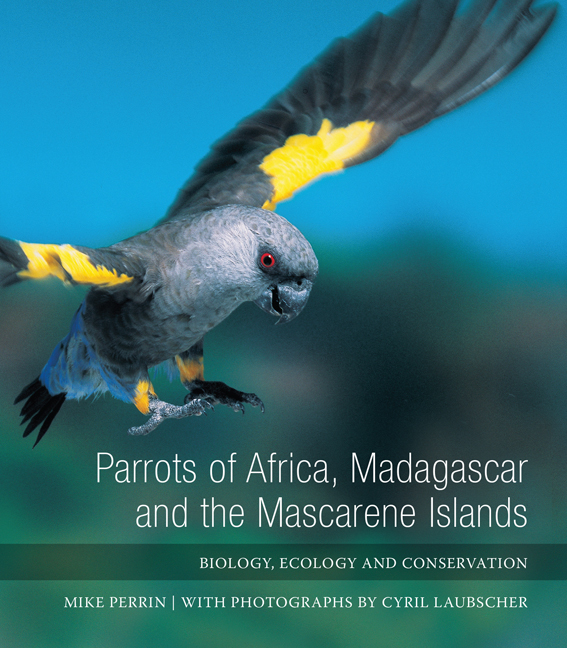Book contents
- Frontmatter
- Contents at a glance
- Contents
- Acknowledgements
- List of tables
- List of figures
- Abbreviations
- Chapter 1 Introduction
- Chapter 2 Conservation Biology
- Chapter 3 Systematics
- Chapter 4 Biogeography and Niche Separation
- Chapter 5 Intelligence, Communication and Behaviour
- Chapter 6 Breeding Biology
- Chapter 7 Diet and Metabolism
- Chapter 8 Case Study – The Cape Parrot
- Chapter 9 Trade in African parrots
- Chapter 10 African Parrot Conservation
- THE PARROT SPECIES OF AFRICA
- IUCN CATEGORIES
- Chapter 11 Long-Tailed and Fossil Parrots
- Chapter 12 True Parrots
- Chapter 13 Lovebirds
- Chapter 14 Field Techniques in Parrot Research
- Species lists
- Glossary
- Bibliography
- Index
Chapter 3 - Systematics
Published online by Cambridge University Press: 04 June 2019
- Frontmatter
- Contents at a glance
- Contents
- Acknowledgements
- List of tables
- List of figures
- Abbreviations
- Chapter 1 Introduction
- Chapter 2 Conservation Biology
- Chapter 3 Systematics
- Chapter 4 Biogeography and Niche Separation
- Chapter 5 Intelligence, Communication and Behaviour
- Chapter 6 Breeding Biology
- Chapter 7 Diet and Metabolism
- Chapter 8 Case Study – The Cape Parrot
- Chapter 9 Trade in African parrots
- Chapter 10 African Parrot Conservation
- THE PARROT SPECIES OF AFRICA
- IUCN CATEGORIES
- Chapter 11 Long-Tailed and Fossil Parrots
- Chapter 12 True Parrots
- Chapter 13 Lovebirds
- Chapter 14 Field Techniques in Parrot Research
- Species lists
- Glossary
- Bibliography
- Index
Summary
EVOLUTIONARY HISTORY (PHYLOGENY)
The determination of the affinities of parrots is one of the most difficult problems to resolve in bird classification (avian systematics). Historically, they were aligned with the raptors or birds of prey, particularly the owls, owing to superficial similarities of the bill, but any such resemblances are obviously due to convergence. The parrots are an ancient, distinct and strongly differentiated group, although divisions within the taxon are disputed. Early classification was based, inter alia, on the structure of the feathers, skull and foot, and the anatomy of the carotid arteries taking blood to the head. More recently, Sibley and Ahlquist (1972) compared the egg-white proteins of ten species of parrots from six genera, using electrophoresis. The observed diversity suggested large genetic gaps between various divergent groups, but consistency within closely related species, including five species of lovebirds. Studies of red cell antigens, eye lens and muscle proteins showed a similar pattern. A study of aspects of behaviour (for example, head-scratching) and anatomy (Brereton & Immelman 1962; Brereton 1963) grouped the three taxa of mainland African parrots (Psittacus, Poicephalus and Agapornis) together in the family Psittacidae.
Forshaw (1989) grouped the parrots and parakeets of Africa with those of Australia and South America in the subfamily Psittacinae. Smith (1975) reviewed the history of the classification of parrots based on the results of his dissections of 126 species from 51 genera and comparisons of external morphology and behaviour of essentially all species. Not surprisingly, he reported a strong correlation between taxonomic divisions and geographical distributions. He recognised three tribes of large African parrots which he placed in the subfamily Psittacinae. DNA data also support the division of parrots into geographically delineated groups (Sibley & Ahlquist 1990). ‘The largest ever study of birds genetics has not only shaken up but completely redrawn the avian evolutionary tree. The study challenges current classifications, alters our understanding of avian evolution, and provides a valuable resource for phylogenetic and comparative studies in birds’ (Borzo 2008). Surprisingly, the new research suggests a close relationship of parrots with passerines (perching birds) and falcons (Wright et al. 2008).
- Type
- Chapter
- Information
- Parrots of Africa, Madagascar and the Mascarene IslandsBiology, Ecology and Conservation, pp. 65 - 82Publisher: Wits University PressPrint publication year: 2012



